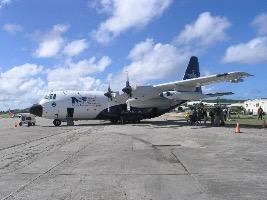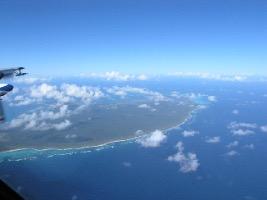The Rain in Cumulus over the Ocean Campaign (RICO) was organized to study shallow, maritime, cumulus convection, one of the most prevalent cloud types on the planet. Trade wind cumuli typically extend to no greater than 4 km altitude, the height of the tropical trade wind inversion, and are dominated by warm rain processes. They are ubiquitous over much of the tropical oceans, and characterizing their properties is important to understanding the global energy balance and climate. Because of the disparity in the range of scales from the microphysical/cloud scale (microns to a kilometer), to the cloud-interaction scale (kilometers to tens of kilometers), to the ensemble cloud field scale (tens of kilometers or more), past work has tended to focus on processes occurring on only one of these three scales – often neglecting the important interactions that occur across scales. Our objective in RICO in the broadest sense was to characterize and understand the properties of trade wind cumulus at all scales, with particular emphasis on determining the importance of precipitation. At the smallest scale, the most fundamental problem – recognized for over a half century – is explaining the rapid onset of precipitation in shallow tropical clouds. At the intermediate scale, processes controlling the mesoscale structure and coverage of shallow tropical cloud systems are not well understood. At the largest scale, our inability to describe the statistical behavior of trade wind cloud fields confounds our attempts to properly represent the exchange of radiant energy, moist enthalpy, momentum and trace constituents between the atmosphere and ocean over vast expanses of the planet. All these scales are inextricably linked and our goal was to explore the nature of these linkages in RICO.
At the University of Illinois, our goals are to quantify and understand (1) the microphysical and environmental processes influencing the rate of precipitation formation in trade wind cumuli. We explored how the warm rain process occurs and the role of sea salt nuclei in enhancing the rate at which rain develops. We approached this using radar and aircraft data; (2) the mechanisms by which precipitation influences the mesoscale organization of trade wind clouds. Our research suggests the importance of precipitation-generated cold pools in reorganizing trade wind clouds. We used satellite and radar data to quantitatively determine properties of cold-pool generated clouds and compared these with clouds generated by other processes. (3) the mechanisms by which clouds and precipitation influence the mesoscale substructure of the marine boundary layer. Our research used the clear air Bragg scattering signal from the RICO S-Band radar. We discovered layered substructures with mesoscale variability that are linked to layers of enhanced humidity. We used the Bragg scattering clear-air signal, together with soundings, to understand the origin and properties of these layered substructures, the role of clouds and precipitation in modifying these substructures, and how these substructures feed back onto subsequent cloud and precipitation evolution; (4) the impact of clouds and cloud processing on the distribution of aerosols within the MBL. We used RICO data, satellite data from CALIPSO, and detailed microphysical modeling to investigate how clouds process aerosols originating in the sub-cloud layer, detrain processed aerosols into halo regions in the immediate cloud vicinity and ultimately redistribute aerosols throughout the marine boundary layer. Below are our publications from this project.
Publications
- Rauber, R. M., K. V. Beard, and B. M. Andrews, 1991: A mechanism for giant raindrop formation in warm, shallow convective clouds. J. Atmos. Sci., 48, 1791–1797.
- Laird, N. F., D. A. R. Kristovich, R. M. Rauber, H. T. Ochs III and L. J. Miller, 1995: The Cape Canaveral sea and river breezes: Kinematic structure and convective initiation. Mon. Wea. Rev., 123, 2942–2956.
- Austin, G. R., R. M. Rauber, H. T. Ochs III and L. J. Miller, 1996: Tradewind clouds and Hawaiian rainbands. Mon. Wea. Rev., 124, 2126–2151.
- Rauber, R. M., N. F. Laird and H. T. Ochs III, 1996: Precipitation efficiency of tradewind clouds over the north-central tropical Pacific Ocean. J. Geophysical Res., Atmospheres, 101, (D21), 26,247– 26,253.
- Szumowski, M. J., R. M. Rauber, H. T. Ochs III and L. J. Miller, 1997: The microphysical structure and evolution of Hawaiian rainband clouds. Part I: Radar observations of rainbands containing high reflectivity cores. J. Atmos. Sci., 54, 369–385.
- Szumowski, M. J., R. M. Rauber, H. T. Ochs III, and K. V. Beard, 1998: The microphysical structure and evolution of Hawaiian rainband clouds. Part II: Microphysical measurements in rainbands containing high reflectivity cores. J. Atmos. Sci., 55, 208–226.
- Szumowski, M. J., R. M. Rauber and H. T. Ochs III, 1999: The microphysical structure and evolution of Hawaiian rainband clouds. Part III: A test of the ultragiant nuclei hypothesis. J. Atmos. Sci., 56, 1980-2003.
- Wang, J.-J., R. M. Rauber, H. T. Ochs III, and R. E. Carbone, 2000: The effects of the Island of Hawaii on offshore rainband evolution. Mon. Wea. Rev., 128, 1052-1069.
- Laird, N. F., H. T. Ochs, R. M. Rauber and L. J. Miller, 2000: Initial precipitation formation in warm Florida cumulus. J.Atmos. Sci., 57, 3740–3751.
- Colón-Robles, M., R. M. Rauber, and J. B. Jensen (2006), Influence of low-level wind speed on droplet spectra near cloud base in trade wind cumulus, Geophys. Res. Lett., 33, L20814, doi:10.1029/2006GL027487.
- Rauber, R.M., B. Stevens, H. T. Ochs III, C. Knight, B. A. Albrecht, A.M. Blyth, C.W. Fairall, J. B. Jensen, S. G. Lasher-Trapp, O. L. Mayol-Bracero, G. Vali, J. R. Anderson, B. A. Baker, A. R. Bandy, F. Burnet, J-L. Brenguier, W. A. Brewer, P. R. A. Brown, P. Chuang,W. R. Cotton, L. Di Girolamo, B. Geert, H. Gerber, S. Göke, L. Gomes, B. G. Heikes, J. G. Hudson, P. Kollias, R. P. Lawson, P. Jonas, S. K. Krueger, D. H. Lenschow, L. Nuijens, D. W. O’Sullivan, R. A. Rilling, D. C. Rogers, A. P. Siebesma, E. Snodgrass, J. L. Stith, D.C. Thornton, S. Tucker, C. H. Twohy, P. Zuidema, 2007: Rain in (Shallow) Cumulus over the Ocean—The RICO Campaign, Bull. Amer. Met. Soc., 88, 1912– 1928.
- Rauber, R.M., B. Stevens, J. Davison, S. Göke, O.L. Mayol-Bracero, D. Rogers, P. Zuidema, H.T. Ochs, C. Knight, J. Jensen, S. Bereznicki, S. Bordoni, H. Caro-Gautier, M. Colón-Robles, M. Deliz, S. Donaher, V. Ghate, E. Grzeszczak, C. Henry, A. Marie Hertel, I. Jo, M. Kruk, J. Lowenstein, J. Malley, B. Medeiros, Y. Méndez-Lopez, S. Mishra, F. Morales-García, L.A. Nuijens, D. O’Donnell, D.L. Ortiz-Montalvo, K. Rasmussen, E. Riepe, S. Scalia, E. Serpetzoglou, H. Shen, M. Siedsma, J. Small, E. Snodgrass, P. Trivej, and J. Zawislak, 2007: In the Driver’s Seat: Rico and Education. Bull. Amer. Meteor. Soc., 88, 1929–1937.
- Rauber, R.M., B. Stevens, H.T. Ochs, C. Knight, B.A. Albrecht, A.M. Blyth, C.W. Fairall, J.B. Jensen, S.G. Lasher-Trapp, O.L. Mayol-Bracero, G. Vali, J.R. Anderson, B.A. Baker, A.R. Bandy, E. Burnet, J.L. Brenguier, W.A. Brewer, P.R.A. Brown, P. Chuang, W.R. Cotton, L. Di Girolamo, B. Geerts, H. Gerber, S. Göke, L. Gomes, B.G. Heikes, J.G. Hudson, P. Kollias, R.P. Lawson, S.K. Krueger, D.H. Lenschow, L. Nuijens, D.W. O’Sullivan, R.A. Rilling, D.C. Rogers, A.P. Siebesma, E. Snodgrass, J.L. Stith, D.C. Thornton, S. Tucker, C.H. Twohy, and P. Zuidema, 2007: A Supplement to Rain in Shallow Cumulus Over the Ocean: The RICO Campaign. Bull. Amer. Meteor. Soc., 88, S12–S18.
- Göke, S., H.T. Ochs, and R.M. Rauber, 2007: Radar Analysis of Precipitation Initiation in Maritime versus Continental Clouds near the Florida Coast: Inferences Concerning the Role of CCN and Giant Nuclei. J. Atmos. Sci., 64, 3695–3707
- Snodgrass, E., L. Di Girolamo, and R. M. Rauber, 2009: Precipitation characteristics of Trade Winds Clouds during RICO Derived from Radar, Satellite and Aircraft Measurements. J. Appl. Meteor. and Climatology. 48, 464-483.
- Minor, Hilary A., Robert M. Rauber, Sabine Göke, Larry Di Girolamo, 2011: Trade Wind Cloud Evolution Observed by Polarization Radar: Relationship to Giant Condensation Nuclei Concentrations and Cloud Organization. J. Atmos. Sci., 68, 1075–1096.
- Davison, Jennifer. L., R. M. Rauber, L. Di Girolamo, and M.. A. LeMone, 2013: A Revised Conceptual Model of the Tropical Marine Boundary Layer. Part I: Statistical Characterization of the Variability Inherent in the Wintertime Trade Wind Regime over the Western Tropical Atlantic. J. Atmos. Sci., 70, 3005–3024.
- Davison, J. L., R. M. Rauber, and L. Di Girolamo, 2013: A Revised Conceptual Model of the Tropical Marine Boundary Layer. Part II: Detecting Relative Humidity Layers Using Bragg Scattering from S-Band Radar. J. Atmos. Sci., 70, 3025–3046.
- Davison, J. L., R. M. Rauber, L. Di Girolamo, and M. A. LeMone, 2013: A Revised Conceptual Model of the Tropical Marine Boundary Layer. Part III: Bragg Scattering Layer Statistical Properties. J. Atmos. Sci., 70, 3047–3062.
- Rauber, R. M., G. Zhao, L. Di Girolamo, and M. Colón-Robles, 2013: Aerosol Size Distribution, Particle Concentration, and Optical Property Variability near Caribbean Trade Cumulus Clouds: Isolating Effects of Vertical Transport and Cloud Processing from Humidification Using Aircraft Measurements. J. Atmos. Sci., 70, 3063–3083.
- Jensen, J. B., S. P. Beaton, J. L. Stith, K. Schwenz, M. Colón-Robles, R. M. Rauber, and J. Gras, 2020: The Giant Nucleus Impactor (GNI)—A System for the Impaction and Automated Optical Sizing of Giant Aerosol Particles with Emphasis on Sea Salt. Part I: Basic Instrument and Algorithms. J. Atmos. Oceanic Technol., 37, 1551–1569, https://doi.org/10.1175/JTECH-D-19-0109.1
- Hu, Y., G. M. McFarquhar, W. Wu, Y. Huang, A. Schwarzenboeck, J. W. Strapp, A. Protat, A. Korolev, R. M. Rauber and H. Wang, 2021: Dependence of Ice Microphysical Properties On Environmental Parameters: Results from HAIC/HIWC Cayenne Field Campaign. J.Atmos. Sci., in press.


